- 8777701917
- info@saikatinfotech.com
- Basirhat W.B
CDP (Cisco Discovery Protocol) and LLDP (Link Layer Discovery Protocol) are both network protocols used for discovering devices on a local network. CDP is Cisco-specific, providing information about directly connected Cisco devices, while LLDP is an open standard that works across various vendors, allowing for broader compatibility in multi-vendor environments.
In this article, we are going to discuss about CDP and LLDP. We will also look at steps to configure CDP and LLDP on Cisco devices and then verify their configuration. Learning about CDP and LLDP is an important task if preparing for any Cisco certification
What is Cisco Discovery Protocol (CDP)?
CDP is a Cisco proprietary protocol specifically used for Cisco devices to discover other connected Cisco devices in the network infrastructure. CDP operates at the data link layer of the OSI model and runs on Cisco devices by default.
It enables devices to discover neighboring Cisco devices directly connected to their interfaces. CDP exchanges information such as device IDs, IP addresses, interface details, platform information, and capabilities. CDP messages are periodically exchanged between the connected devices to maintain the CDP neighbor table.
What is Link Layer Discovery Protocol (LLDP)?
LLDP is a vendor-neutral and standardized protocol defined by the IEEE 802.1AB standard. Similar to CDP, LLDP operates at the data link layer and provides a mechanism for discovering neighboring devices. LLDP can be used on a wide range of network devices, regardless of the vendor.
It allows devices to exchange information such as system and port identifiers, port descriptions, capabilities, and management addresses. LLDP is often used in multi-vendor environments, enabling devices from different manufacturers to discover and communicate with each other.
Both CDP and LLDP provide benefits such as network discovery, inventory management, and troubleshooting. They help network administrators gather information about the network topology, identify connected devices, and ensure proper configuration and compatibility.
By utilizing these protocols, administrators can gain visibility into their networks and facilitate effective network management and troubleshooting tasks
Difference Between CDP and LLDP
Let’s quickly check the CDP and LLDP differences. The table below shows key differences between CDP and LLDP highlighting their functionalities, usage scenarios, and configurations.
| Feature | CDP (Cisco Discovery Protocol) | LLDP (Link Layer Discovery Protocol) |
|---|---|---|
| Vendor Specificity | Cisco proprietary | Open standard, vendor-neutral |
| Purpose | Discovers Cisco devices and their capabilities | Discovers devices across different vendors |
| Information Shared | Device ID, IP address, capabilities | Device ID, port description, VLAN information |
| Layer | Operates at Layer 2 | Operates at Layer 2 |
| Usage | Primarily in Cisco environments | Used in multi-vendor environments |
| Configuration | Enabled by default on Cisco devices | Requires manual configuration on devices |
| Security Features | Limited security features | Can include security features like authentication |

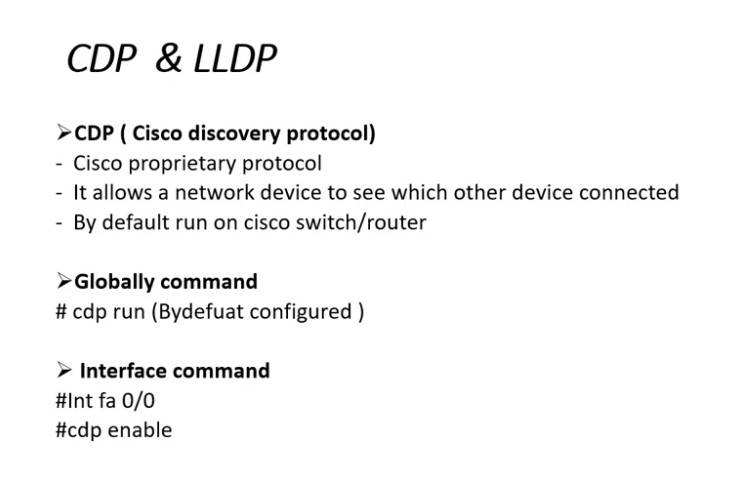

What is CDP and LLDP used for?
CDP and LLDP are used for discovering and sharing information about directly connected network devices, enabling efficient network management and troubleshooting.
Is LLDP more secure than CDP?
LLDP can include security features like authentication, making it potentially more secure than CDP, which has limited security features.
Can I run LLDP and CDP at the same time?
Yes, you can run LLDP and CDP simultaneously on Cisco devices, as they operate independently and provide complementary information about connected devices.
What is CDP configuration?
CDP configuration involves enabling Cisco Discovery Protocol on a device to discover neighboring Cisco devices and gather information such as device capabilities and IP addresses. This is typically done using the command cdp run in global configuration mode.
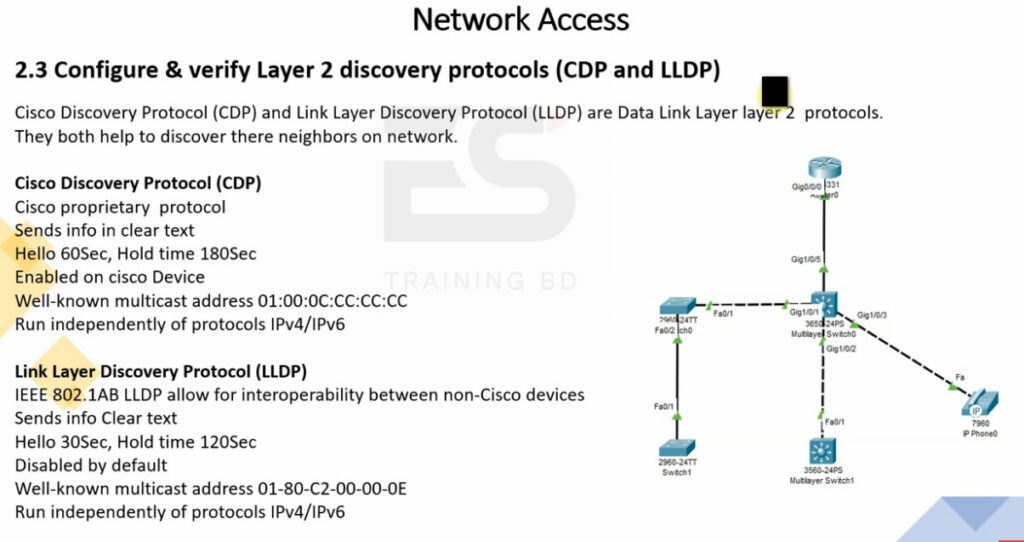
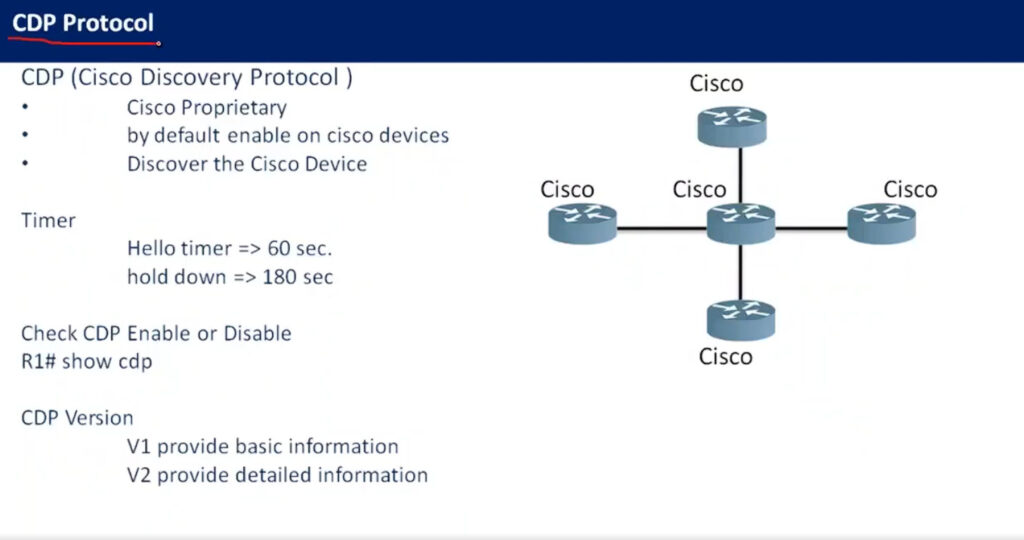
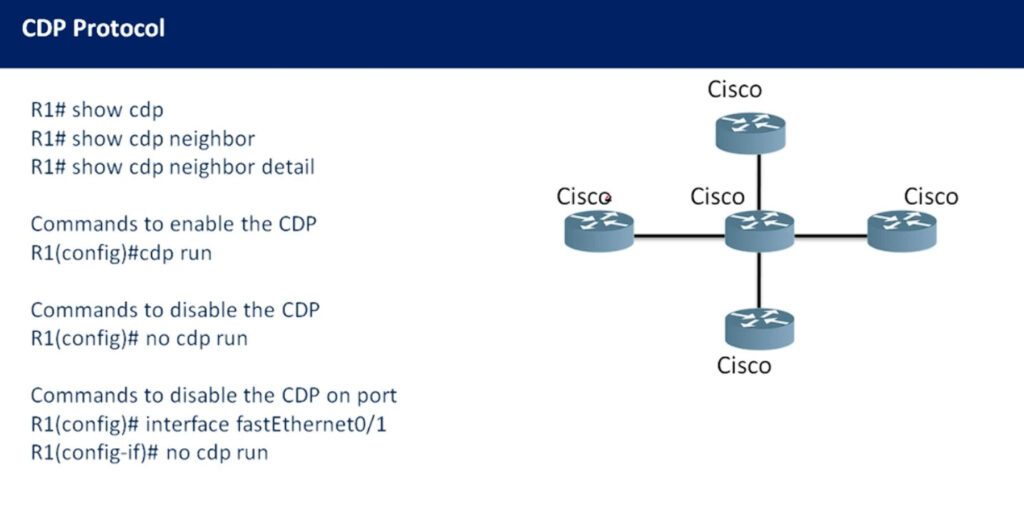
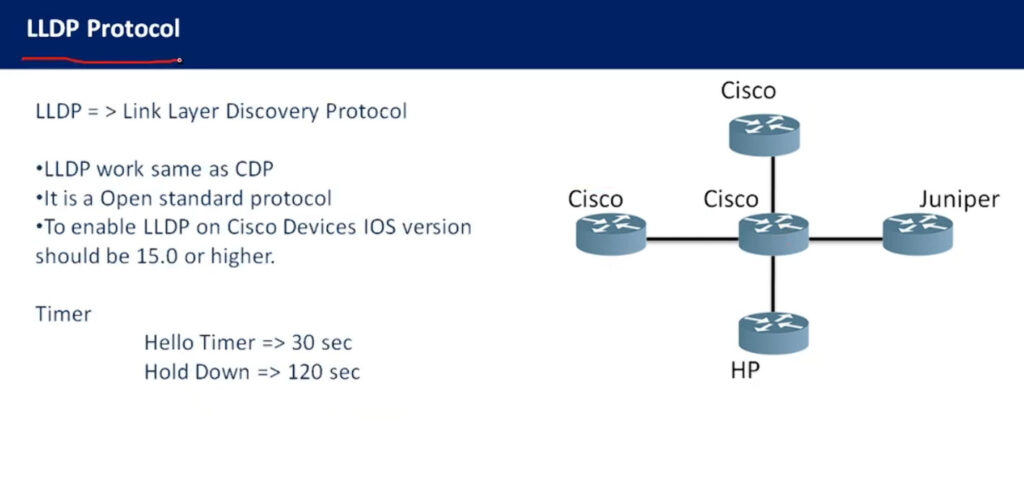
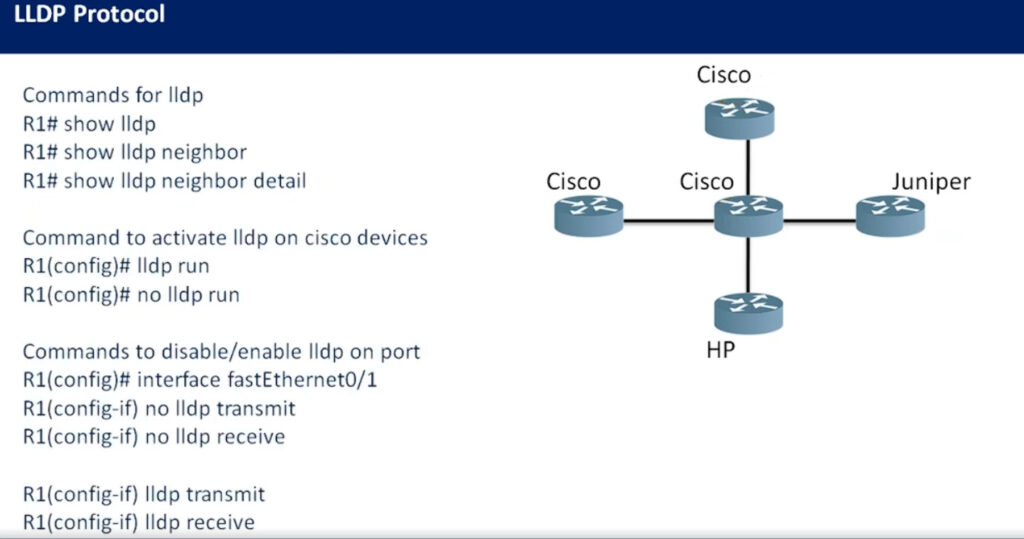
CDP
---
show cdp
show cdp neighbor
show cdp neighbor detail
Enable CDP
----------
cdp run
Disable CDP
-----------
no cdp run
LLDP
----
show lldp
show lldp neighbor
show lldp neighbor detail
Activate LLDP
-------------
lldp run
no lldp run
Disable/Enable LLDP on Port
---------------------------
int fa0/1
no lldp transmit
no lldp recive
To configure cdp Hello time and Hold time, you can use the below commands.
Time is mentioned as seconds.
-----------------------------------------------------------
Switch(config)# cdp timer 50
Switch(config)# cdp holdtime 100
To clear the CDP table, use the “clear cdp table” command.
--------------------------------------------------------
Switch# clear cdp table
To verify CDP, you can use general CDP verification commands below:
-------------------------------------------------------------------
Switch# show cdp
Switch# show cdp interface
Switch# show cdp neighbors
Switch# show cdp entry
Switch# show cdp traffic
CDP Disable For Interfaces
--------------------------
fa0/10
no cdp run